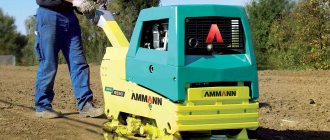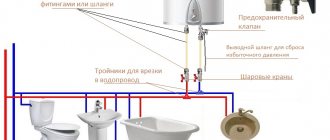Principle of operation
Manual tile cutters are mechanical tools.
Their operating principle is similar to a glass cutter. The tools are compact in size and light in weight. They are easy to carry. The material is carved by a protruding roller, which is driven manually using a special handle. It is mounted on a carriage mounted on the tile cutter bed.
Pressing the handle creates a roller load on the material being processed, which leads to its breaking along the cutting line. The horizontal movement of the roller is ensured by a rail mechanism mounted on the frame.
It may consist of:
- From an I-beam.
- 2 parallel tubes.
The material to be processed for cutting is placed on the base of the bed, equipped with special shock-absorbing pads. The tile cutter itself must stand on a hard surface while working. During cutting, the roller rubs against the material, causing it to heat up. To cool it and prevent dust formation during operation, tile cutters are equipped with water reservoirs. Some models are equipped with a rotating ruler.
How to choose a manual tile cutter
When a person understands the characteristics of a tile cutter, it is easier for him to choose a tool to perform certain tasks. Manual models have a simple design. They consist of a frame on which guide elements are securely fastened. A carriage with a cutter moves along them.
All manual tile cutters have a similar basic structure
bed
The element is a metal platform on which the working units are fixed. It should be reliable and not vibrate. The rigidity of the bed indicates the first sign of a good quality tool. If the base vibrates while cutting, the tile will crack.
Platform length
When choosing a manual tile cutter, pay attention to this parameter first of all. The length of the bed determines what size tiles can be cut. It is optimal not to save money, but to purchase a long tool. It can cut small wall tiles and large floor tiles.
Smooth carriage movement
Manual models come with and without bearings. The first tool is characterized by a smooth carriage movement. The cut is smooth without gaps or double lines. The absence of bearings impairs smooth running. However, many owners buy such tile cutters because of the budget cost. You can only check it at work. To do this, cut a couple of tiles. The carriage should slide well along the guides, and the workpiece should break exactly along the cut line.
Advice! It's better to shell out for an expensive hand tool with bearings. In the future it will pay off, maybe it will be useful for hired work.
Cutter
The cutting element of a manual tile cutter is a roller. It is made of carbide steel. Over time it becomes dull. The roller cannot be sharpened. As it wears out, it is simply replaced.
Additional items
Manufacturers equip different models with rotating rulers and adjustment elements for adjusting the thickness of the material being cut. All these functions improve the quality of the cut, but such tile cutters are expensive.
The video shows an example of a review of a manual tile cutter:
Classification
Tile cutters produced by manufacturers are divided according to their operating principle into:
- Roller.
- Bearing.
Roller tools are used for cutting piece tiles at right or arbitrary angles. After securing the tiles to the rubberized base of the bed, a roller with a cutting mechanism under pressure is guided along the cutting line. In professional tools, the cutting mechanism is driven by bearings mounted on guide rails.
Expert opinion
Torsunov Pavel Maksimovich
The use of radial bearing designs significantly increases tool life and improves tool quality and productivity. Each type of tool has its own technical characteristics, including the cutting range. Manual tile cutters can cut material with a thickness of 4 to 20 mm.
Which tile cutter is better - manual or electric?
To understand this issue, you need to consider the principle on which each tool works. To cut the tile with a hand tool, it is fixed on the bed. The cutting roller must coincide with the markings applied to the workpiece. The cut begins from the edge of the tile, moving and pressing the carriage with the cutting roller using a lever. You can move as desired: away from you or towards yourself. When the furrow is cut, place the foot on the line and press the lever. The tile should split exactly along the cut line.
Manual tile cutter is operated by hand force
The advantage of the tool is its lower cost compared to its electric counterpart. It is reasonable to purchase an inexpensive, good manual tile cutter for home use when you need to cut a small amount of tiles.
When doing a lot of work, cutting hundreds of tiles by hand is difficult. For such purposes, choose a power tool. It works on the principle of an angle grinder. The electric motor drives the diamond-coated cutting disc. The tiles are cut on the machine in a couple of seconds. The disadvantage is the large amount of dust. In addition, during cutting, the tile overheats and can crack. The problem is solved by using a water-cooled tile cutter. Liquid from the tank is supplied directly to the cutting line.
An electric machine can cut tiles of large sizes and thicknesses
The depth of cut depends on the diameter of the disc. However, the size of the circle must correspond to the power of the engine, otherwise it will quickly overheat due to overload. Electric machines come with an upper and lower motor position relative to the working platform. Many models are capable of changing the cutting angle up to 45°, cutting round holes in the tiles for pipes and other communications.
It is difficult to determine exactly which tile cutter is better. Each tool is good in its own way. You need to be guided by the volume of work. It’s not enough to cut the tiles; choose a manual model. Large volumes of work are envisaged; electric tools are required.
TOP 7 popular models
When choosing a tool for work, you can be guided by ratings. They are compiled based on the opinions of specialists working with them.
Bison 33193-80
The model is simple in design and easy to use. Her weight is 10.4 kg. This provides the structure with the stability necessary for operation. The main purpose of the Bison is domestic use. The model is designed for cutting porcelain tiles and ceramic tiles. Working thickness range from 0.5 to 1.6 cm.
Advantages:
- Reinforced design.
- Small dimensions.
- Low price.
Flaws:
- No desktop.
- Cannot cut stone.
The model has a 3-year warranty. The average cost is 5.6 thousand rubles. Country of origin: Russia.
Dmitry B. review:
A reliable machine for its price. The set includes a bag. The disadvantage is rapid wear of the cutting roller.
Encore 3660
Cheap compact machine. Model weight 2 kg. Encor 3660 is designed for cutting ceramic tiles. Equipped with a high-quality cutting roller. It has a reliable base and a flat working surface. The rubber coated handle ensures safety during operation.
Advantages:
- The machine ensures threading of the material without chipping.
- Low price.
- Light weight.
Flaws:
- When working with a tile cutter, physical effort is required.
- Small cutting depth up to 6 mm.
Average cost 880 rub. Country of origin: China.
Nikita G. review:
The machine requires caution when operating. May break the tile rather than cut it.
Montolit Masterpiuma 63P3
The machine can be used in everyday life and professional activities. Designed for cutting porcelain stoneware and ceramic tiles. The model is equipped with a floating handle. This greatly simplifies the work process. The tile cutter produces an even cut. The design includes additional devices: ruler, protractor, etc.
Advantages:
- Small mass.
- Spare rollers included.
- Has the ability to cut diagonally.
The disadvantages include the difficulty of adjusting the cutting.
The average cost is 22 thousand rubles.
Oleg M. review:
I have been working with this model of tile cutter for 3 years. Rating 5. Country of origin: Italy.
Rubi Star-61
Multifunctional machine. Designed for cutting all types of tiles, including tiles and mosaics. The model has a reinforced base and an additional bed for laying material. It can accommodate cutters of different diameters. This allows. Maneuver when cutting with the size of the tile.
Advantages:
- Smooth cut.
- Shock-absorbing base.
- Stable design.
The average cost is 6.6 thousand rubles. Country of origin: China.
Vladislav M. review:
Reliable machine. Gives a quality cut. The set includes a bag.
Bars 87590
Monorail machine. Designed for cutting ceramic tiles. The carriage is located on 2 bearings. A ruler is provided to set dimensions. The material of manufacture is aluminum. The handle is reinforced. Weight 10.5 kg.
Advantages:
- Affordable price.
- Compactness.
- Possibility of cutting ceramic tiles and porcelain stoneware.
Disadvantage: small cutting depth.
The average cost is 4.4 thousand rubles. Country of origin: Russia.
Alexander U. review:
I am pleased with the performance of the tool. Simple and reliable to use.
SIGMA 2A3
Lightweight, compact, multifunctional tool. The machine has 2 cutting systems. Designed for professional use. Provides fast and high-quality cutting.
Advantages:
- Availability of a high precision ruler.
- Smooth ride.
- Suitable for working with thin ceramics.
The disadvantages include the high cost of the tool.
The average cost is 9 thousand rubles.
Mikhail Sh. review:
I use a tile cutter for tiles of various thicknesses. Gives a quality cut. Reliable at work.
MATRIX 600X16 mm with ballerina
The machine has a simple design and a durable frame. Reliable in operation. The design has a ballerina for cutting shaped holes in the tiles. Designed for professional work.
Advantages:
- Carbide roller.
- Compactness.
- Affordable price.
- Wide functionality.
Disadvantage: the ballerina does not cut through thick tiles.
The average cost is 2.5 thousand rubles.
Andrey K. review:
Lightweight, convenient tool. Cuts porcelain tiles well.
How to cut tiles: step-by-step instructions
- Step 1. Work begins by installing the machine on a hard surface.
- Step 2. Mark the cutting line on the front side of the material.
- Step 3. The tile is laid on the working surface and rests against the far side of the machine, after which the cut line is adjusted.
- Step 4. The cutter handle moves towards itself.
- Step 5. The cutter is drawn along the cutting line.
- Step 6. Press the lever to break the tile at the location of the furrow.
What manual tile cutter do you use?
Roller Bearing










